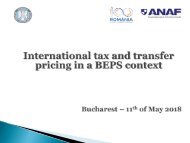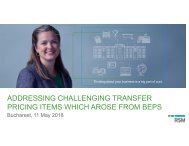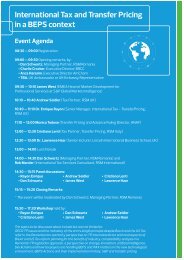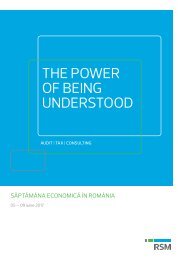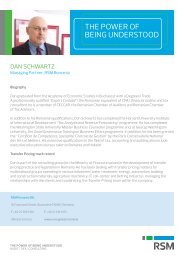5. Italian Iternational Taxation - What's new - Cristiano Lenti
Create successful ePaper yourself
Turn your PDF publications into a flip-book with our unique Google optimized e-Paper software.
RSM Italy 2018<br />
<strong>Italian</strong> International <strong>Taxation</strong><br />
What’s <strong>new</strong><br />
RSM Studio Palea Lauri Gerla
Italy what’s <strong>new</strong><br />
In the last months the <strong>Italian</strong> Government has made a few changes in the International Tax regulations. The main<br />
topics affected by the modifications are:<br />
Permanent Establishment Arm’s length principle Corresponding adjustments<br />
In order to be consistent with the<br />
innovations deriving by the BEPS<br />
project, the 205/2017 <strong>Italian</strong> Budget<br />
Law amends the concept of<br />
permanent establishment. The<br />
modifications are aimed at transpose<br />
the concept stated in the Action 7<br />
“Preventing the Artificial Avoidance<br />
of PE status” and Action 1 relating to<br />
the field of “Digital Economy”.<br />
For many years, <strong>Italian</strong> transfer<br />
pricing law has used the concept of<br />
“normal value” as the basis for<br />
pricing intercompany transactions.<br />
This concept was similar to the<br />
OECD arm’s length principle,<br />
although not precisely the same and<br />
potentially open to various<br />
interpretation. The <strong>new</strong> definition<br />
formally endorses the OECD<br />
standard.<br />
Art. 31-quater of Presidential Decree<br />
n. 600 of 1973 introduce a<br />
procedure allowing <strong>Italian</strong> taxpayers<br />
to obtain a unilateral downward<br />
adjustment on their taxable income<br />
as a result of transfer pricing<br />
adjustment made by foreign tax<br />
authorities as opposed to initiating<br />
the ordinary mutual agreement<br />
procedure (MAP)<br />
RSM Studio Palea Lauri Gerla
Permanent establishment – what’s <strong>new</strong><br />
Article 162 of the Consolidated <strong>Italian</strong> Law on Income Tax<br />
On 18 December 2017, the OECD released the 2017 OECD Model Tax Convention which incorporates significant changes developed under the<br />
OECD/G20 project to address base erosion and profit shifting. The <strong>Italian</strong> Government, in order to be compliant with the <strong>new</strong> rules for the<br />
identification of the PE status has released <strong>new</strong> measures reflecting a broader definition of permanent establishment (PE) for <strong>Italian</strong> law. The<br />
main changes are described below.<br />
01<br />
02<br />
03<br />
04<br />
• A permanent establishment is also deemed to be a 'significant and continuous economic presence in the territory of Italy,<br />
built in such a way that it will not result in a physical presence in Italy’;<br />
• The preparatory and auxiliary activities of a non-resident enterprise that do not give rise to a permanent establishment are<br />
specifically defined;<br />
• Activities performed by closely-related enterprises at a fixed place of business are analysed together for the purpose of<br />
evaluating whether they may qualify as preparatory or auxiliary, provided that the business activities of the closely-related<br />
enterprises constitute complementary functions that are part of a cohesive business operation.<br />
• An independent person acting in Italy exclusively or almost exclusively on behalf of one or more enterprises to which<br />
the person is closely related, does not qualify as an independent agent and therefore gives rise to a permanent<br />
establishment of the nonresident enterprise.<br />
RSM Studio Palea Lauri Gerla
Permanent establishment – what’s <strong>new</strong><br />
01 New Economic Nexus<br />
The <strong>new</strong> definition implies the possibility of a PE presence even in the case where a company does not have a physical presence in the <strong>Italian</strong> territory<br />
to the extent other factors may indicate a significant presence (e.g., revenues, number of customers etc). The <strong>new</strong> provision on the economic nexus<br />
would seem to originate from and be consistent with the OECD final report on the tax challenges of the digital economy (Action 1). In fact, starting<br />
from 1 January 2019 in Italy will be in force a “web tax” with the following features:<br />
• B2B only – Web Tax applies exclusively to business-to-business (B2B) digital transactions. Business-toconsumer<br />
(B2C) digital transactions will be excluded from the application of the <strong>new</strong> tax. Also the online<br />
sale of goods (e-commerce) B2B would seem to be excluded.<br />
• 3% rate and 3,000 transactions threshold – Web Tax is applied at the rate of 3% on the value of any<br />
transaction, exclusive of VAT and is due only by operators performing more than 3,000 digital transactions<br />
yearly. Whether this minimum threshold is met or not must be communicated by the service provider on the<br />
invoice issued to the client or in another document to be issued together with the invoice.<br />
• Collected by the purchaser – The Web Tax is collected a bit like a withholding tax. The purchaser is<br />
responsible for charging and collecting the Web Tax and for all obligations relating to the tax. The tax must<br />
be paid by the 16th day of the month following the one in which the payment for the digital service occurs.<br />
• Compliance – The provisions on Value Added Tax apply to the assessment, penalties, and the collection of<br />
the Web Tax and related proceedings<br />
BEPS – Action 1<br />
This <strong>new</strong> P.E. definition<br />
is based on the nexus<br />
rules proposed for the<br />
digital economy<br />
by Action 1 so that<br />
nonresident digital<br />
companies can trigger<br />
taxable presence in a<br />
country in ways that are<br />
not uncommon in the<br />
digital economy<br />
RSM Studio Palea Lauri Gerla
Permanent establishment – what’s <strong>new</strong><br />
02 Preparatory and auxiliary activities<br />
The second change concerns the enactment of an additional requirement to the negative list of activities which<br />
are excluded from the definition of permanent establishment. For the exclusions to apply, it is required that<br />
each of those activities be preparatory or auxiliary in nature. A preparatory activity precedes the enterprise’s<br />
core business activities, while an auxiliary activity supports, but is not an essential and significant part of, the<br />
activity of the enterprise as a whole.<br />
The list of exempting activities has been rephrased to provide that a fixed place of business will not constitute a<br />
P.E. if the taxpayer can prove that any and all activities – and not only their combination as under the old rule<br />
– have a preparatory or auxiliary nature with respect to business of the foreign entity. The amendment applies to<br />
any business activity. It may be particularly relevant for digital enterprises based abroad that maintain a stock<br />
of goods in Italy to provide prompt delivery to customers. As a consequence, the maintenance of a local<br />
warehouse and the storage of goods in the warehouse might be regarded as a core activity for digital enterprises<br />
focused on retail purchases. For these businesses, storage would not fall within the preparatory and auxiliary<br />
exemption.<br />
BEPS – Action 7<br />
The Report states that:<br />
“Depending on the<br />
circumstances, activities<br />
previously considered to<br />
be merely “preparatory<br />
or auxiliary in nature<br />
may nowadays<br />
correspond to core<br />
business activities”<br />
RSM Studio Palea Lauri Gerla
Permanent establishment – what’s <strong>new</strong><br />
03 Anti-fragmentation rule<br />
The <strong>new</strong> definition aimed at preventing foreign companies from splitting up a business into smaller units or using other related legal entities or<br />
P.E.’s to benefit from the preparatory or auxiliary exemption. In substance the <strong>new</strong> rules are designed to take into account not only the activities<br />
carried on by the same enterprise at different locations but also of the activities carried on by closely related enterprises at the same or different<br />
locations.<br />
Complementary functions<br />
The business activities<br />
carried on by the two<br />
enterprises at the same<br />
place, or by the<br />
enterprise(s) at the two<br />
locations, constitute<br />
complementary functions<br />
that are part of a cohesive<br />
business operation.<br />
Be part of a Group<br />
The same enterprise or a<br />
closely related enterprise<br />
carries on business<br />
activities at the same<br />
location or another location<br />
in the <strong>Italian</strong> territory<br />
RSM Studio Palea Lauri Gerla<br />
Anti-fragmentation<br />
Rule<br />
Combination of activities<br />
The location(s) constitutes a<br />
P.E. for either enterprise<br />
under the provisions of Art.<br />
162, or the overall activity<br />
resulting from the combination<br />
of the activities carried on by<br />
the two enterprises at the<br />
same place, or by the<br />
enterprise(s) at the two<br />
locations, are not of a<br />
preparatory or auxiliary<br />
character<br />
BEPS – Action 7<br />
The so-called antifragmentation<br />
rules – is<br />
proposed<br />
in Action 7 – aimed at<br />
preventing foreign<br />
companies from splitting<br />
up a business<br />
into smaller units or<br />
using other related legal<br />
entities or P.E.’s to<br />
benefit from<br />
the preparatory or<br />
auxiliary exemption
Permanent establishment – what’s <strong>new</strong><br />
04 Independent Agent<br />
The fourth change concerns the definition of "dependent agent" permanent establishment. A permanent establishment now includes a dependent<br />
agent who habitually plays the principal role leading to the conclusion of contracts that are routinely concluded without material modification<br />
by the enterprise, and these contracts are:<br />
In the name of the enterprise; or<br />
For the transfer of the ownership of, or for the granting of the right to use, property owned by that<br />
enterprise or that the enterprise has the right to use; or<br />
For the provision of services by that enterprise.<br />
The <strong>new</strong> provision covers commissionaire arrangements, whereby the agent does not sign contracts in<br />
the name of the enterprise, but promote the conclusions of contracts that are entered into by the enterprise<br />
without material modifications.<br />
BEPS – Action 7<br />
The Report states that:<br />
“a person will not be<br />
considered to be an<br />
independent agent if it<br />
acts “exclusively or<br />
almost exclusively on<br />
behalf of one or more<br />
enterprises to which it is<br />
closely related”<br />
RSM Studio Palea Lauri Gerla
Arm’s length principle – what’s <strong>new</strong><br />
Article 110(7) of the Consolidated <strong>Italian</strong> Law on Income Tax<br />
The <strong>Italian</strong> Government introduced an important changes affecting the definition of the arm’s length principle for transfer pricing purposes. Art. 59<br />
of Law Decree n.50/2017, in fact, replaced the concept of “normal value” mentioned in Art. 110 paragraph 7 of the ITC, fully aligning the wording<br />
of the domestic rule with the OECD arm’s length principle.<br />
Before<br />
After<br />
The previous wording of Art. 110(7)<br />
stated that elements of income arising<br />
from transactions with non resident<br />
companies which control - directly or<br />
indirectly – the enterprise, ora are<br />
controlled by the same enterprise, are<br />
evaluated on the basis of the «normal<br />
value» of the good supplied, the services<br />
rendered and the goods and services<br />
received.<br />
The amended provision, profit from<br />
transactions between <strong>Italian</strong> enterprises<br />
and related foreign enterprises shall be<br />
estimated “by reference to the<br />
conditions and prices that would have<br />
been agreed between subjects<br />
operating in open market conditions<br />
under comparable circumstances”<br />
RSM Studio Palea Lauri Gerla
Arm’s length principle– what’s <strong>new</strong><br />
Article 110(7) of the Consolidated <strong>Italian</strong> Law on Income Tax<br />
The amended provision referred to further guidance on the transfer pricing criteria and methods, in line with the respective OECD Guidelines, to<br />
be provided by virtue of the forthcoming Ministerial Decree.<br />
In this regard, the Ministry of Economy and Finance launched on February 21 2018 a public consultation on the Draft Ministerial Decree (draft<br />
decree), which contains the guidelines on the application of transfer pricing rules.<br />
In particular, the draft covers the following topics:<br />
Definitions to be considered within a transfer pricing context, i.e. related parties, controlled transactions, terms of transaction, etc. In<br />
particular, following the draft decree, the concept of control seems to be related to the cases where a company owns, directly or<br />
indirectly, more than 50% of the shares of another company as well as to all cases in which a set of circumstances is indicative of a<br />
given company’s influence over the entrepreneurial decision of another;<br />
Notion of comparability and economically relevant characteristics to be taken into account for the comparability analysis; in this<br />
regard, the provisions of the draft decree are fully aligned with the OECD Guidelines;<br />
Circumstances under which more transactions could be aggregated for transfer pricing purposes; in this regard, in cases where<br />
separate transactions are so closely linked or continuous that they cannot be evaluated adequately on a separate basis, the draft<br />
decree provides the possibility to “aggregate” transactions for the comparability analysis and for the selection of the most appropriate<br />
method;<br />
Criteria for selecting the best transfer pricing method to be adopted in accordance with OECD guidelines. The draft decree<br />
underlines that the audit by the tax authority must be performed on the basis of the transfer pricing method selection by taxpayer;<br />
Determination of the arm’s-length range; in this regard, the provisions of the draft decree are fully aligned with the OECD Guidelines.<br />
RSM Studio Palea Lauri Gerla
Corresponding adjustment – what’s <strong>new</strong><br />
Article 31 quarter Presidential Decree No. 600/1973<br />
The Decree contains a <strong>new</strong> provision that extends the range of possibilities avalable to <strong>Italian</strong> taxpayers to mitigate double taxation arising<br />
from transfer pricing adjustments by introducing Article 31 quater of Presidential Decree No. 600/1973, the <strong>Italian</strong> code governing tax<br />
assessments. Before the Decree, obtaining corresponding adjustments was possible only through the mutual agreement procedure (MAP),<br />
including the EU Arbitration Convention. Now it is also possible to obtain a corresponding adjustment in the following conditions:<br />
1<br />
2<br />
3<br />
The foreign primary Transfer Pricing<br />
adjustment is final, i.e. not subject to<br />
modifications<br />
The foreign Country has concluded a<br />
double tax treaty with Italy which allows an<br />
adequate exchange of information<br />
The foreign primary Transfer Pricing adjustment is<br />
compliant with the arm’s length principle<br />
BEPS – Action 14<br />
The Report states that:<br />
“it would be more<br />
efficient if<br />
countries would also<br />
have the possibility to<br />
provide for<br />
corresponding<br />
adjustments<br />
unilaterally in cases in<br />
which they find the<br />
objection of the taxpayer<br />
to be justified”<br />
RSM Studio Palea Lauri Gerla
Corresponding adjustment – what’s <strong>new</strong><br />
Dispute Resolution<br />
Map Under EU AC Map Under MTC Art 31 quater<br />
• Certain elimination of double<br />
taxation;<br />
• If no agreement is reached the<br />
contracting states must elect an<br />
arbitation board;<br />
• The tax negotiation occurs<br />
between two tax authorities and<br />
not between the taxpayer and the<br />
tax authorities (with the<br />
consequent balance of “negotial<br />
power”);<br />
• Possible suspension of tax<br />
collection;<br />
• Should be settled in 2 years;<br />
• Does not allow to contrast<br />
eventual internal tax court’s final<br />
judgment<br />
• The tax negotiation occurs<br />
between two tax authorities;<br />
• Possible suspension of tax<br />
collection;<br />
• Possible, not certain, elimination<br />
of double taxation (if the MTC do<br />
not include par. 5 of art. 25);<br />
• If no agreement is reached the<br />
taxpayer should request an<br />
arbitation board;<br />
• Does not allow to contrast<br />
eventual internal tax court’s final<br />
judgment.<br />
• The decision to eliminate the<br />
double taxation is taken<br />
autonomously by the <strong>Italian</strong> Tax<br />
Authority;<br />
• No need to start a litigation<br />
procedure or a Mutual<br />
Agreement Procedure;<br />
• Allows to continue the domestic<br />
and international litigation;<br />
• No certainty of a positive<br />
outcome.<br />
RSM Studio Palea Lauri Gerla
RSM Studio Palea Lauri Gerla<br />
Thank you for the<br />
attention






